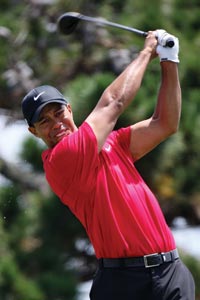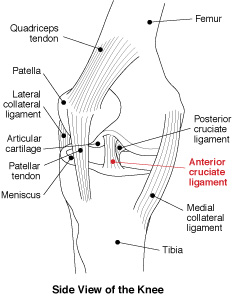
Almost two years after successful surgery to repair a torn ACL, Michelle Backus of Gaithersburg, Md., is once again playing soccer and running track.
Photo courtesy of David George Photography
Two years ago, then-15-year-old Michelle Backus was out-maneuvering a teammate during soccer practice when she heard "a pop" coming from her left knee. The pain was instantaneous. "It felt like glass breaking," she says, "I fell over, and I knew it wasn't good."
Michelle had just torn a part of her knee called the anterior cruciate ligament, or ACL. All too common among athletes, an ACL injury is usually caused by a sudden deceleration or landing maneuver with the leg in a vulnerable position. Although ACL injuries are most often seen in team sports, 70 percent are incurred with little or no contact with another athlete. As with Michelle, the athlete often reacts to a nearby player, and the sudden movement causes the ACL tear.
Recent studies have shown that young female athletes sustain more ACL injuries than young males. In fact, young women are two to eight times more likely than their male counterparts to injure that ligament, according to Dr. Barry Boden of the Orthopedic Center in Rockville, Md. Michelle was one of Dr. Boden's ACL patients.
There are many different theories as to why young women suffer a higher rate of ACL injuries. "One thought is that women have more of a knock-knee alignment," says Dr. Boden, who is conducting research on the injury with funding from the National Institutes of Health. "The alignment of women's knees tends to bend inward when women land." Some researchers believe that this inward bend may predispose women to ACL injuries. Dr. Boden says there are other theories based on how estrogen affects the ligament, as well as the idea that women are "ligament dominant" rather than "muscle dominant."

Golf great Tiger Woods will miss the remainder of the 2008 season due to an ACL injury and a double stress fracture in his left leg.
Photo: Ross Kinnaird/Getty Images
Dr. Boden believes that one of the major reasons any athlete suffers ACL damage is because they land in a flat-footed position, as opposed to landing on the balls of their feet. "If the calf muscles are not absorbing the force, and if the knee is not in the proper position, the knee buckles and tears the ACL," explains Dr. Boden.
After her initial diagnosis and a round of physical therapy, Michelle had her ACL surgery. The procedure took longer than anticipated because Dr. Boden discovered that Michelle also had a meniscal (cartilage) tear. Three days after the surgery, she was back at physical therapy. During her six months of therapy, Michelle learned how to jump and land properly to minimize the chances of re-injuring her ACL.
Almost two years later, Michelle is still playing soccer, as well as running track. She has found that the physical therapy has even helped her with track. "I run hurdles, and now I use my left leg as my lead leg because it is more flexible." The physical therapy had an even greater impact on Michelle—it helped her decide on her future career. The rising senior wants to study physical therapy in college.
Fast Facts
- An anterior cruciate ligament (ACL) injury is usually caused by a sudden twisting motion in the knee when an athlete lands or steps.
- Young women are two to eight times more likely than young men to injure the ACL.
- Landing on the balls of your feet, rather than flat-footed, may help prevent ACL injuries.

